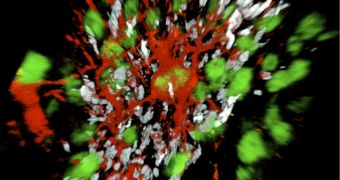Scientists at the University of California in Irvine (UCI) announce the development of a method of using human neural stem cells to heal chronic spinal cord injuries in mouse models.
The therapy is apparently able to restore mobility in animals that suffered serious injuries in their spines, the team explains. The finding could have significant implications.
One of them is the fact that treating paralysis induced by spinal cord damage could soon become possible. Motor function could be restored at least partially, scientists appear to believe.
The UCI study is also ahead of its time from an additional point of view. It represents the first instance ever when researchers demonstrated that curing long-term hind-limb paralysis in mice is possible.
In order to make this possible, the group used human neural stem cells, which proved to be capable of making a difference even in the late stages of an injury.
Past experiments had shown that the stem cells were capable of reversing the damage made to the spinal cord if they were applied to the injured site within a few weeks of the accident.
But the new discovery shows that this is not necessarily the case, as the neural stem cells' effect appears to exist independent of when the therapy is applied.
What this means is that, once a cure for paralysis is synthesized, it could be administered to people already suffering from the condition for many years, and not only to those who develop it after the new therapies are created.
The research effort was conducted by UCI Sue and Bill Gross Stem Cell Research Center experts Aileen Anderson and Brian Cummings. Their work is detailed in the latest online issue of the open-access, peer-reviewed scientific journal PLoS ONE.
“Human neural stem cells are a novel therapeutic approach that holds much promise for spinal cord injury. This study builds on the extensive work we previously published in the acute phase of injury and offers additional hope to those who are paralyzed or have impaired motor function,” says Anderson.
The expert is an associate professor of physical medicine and rehabilitation, and anatomy and neurobiology at the university. Cummings is an associate professor with the same specialties.
“About 1.3 million individuals in the U.S. are living with chronic spinal cord injury. This latest study provides additional evidence that human neural stem cells may be a viable treatment approach for them,” Cummings adds.
“The strong preclinical data we have accumulated to date will enable our transition to a clinical trial, which we plan to initiate in 2011,” adds Dr. Stephen Huhn.
He is the vice president and head of the Central Nervous System Program at the Palo Alto, California-based company StemCells Inc., which deals with the development and commercialization of stem cell therapeutics and tools.

 14 DAY TRIAL //
14 DAY TRIAL //